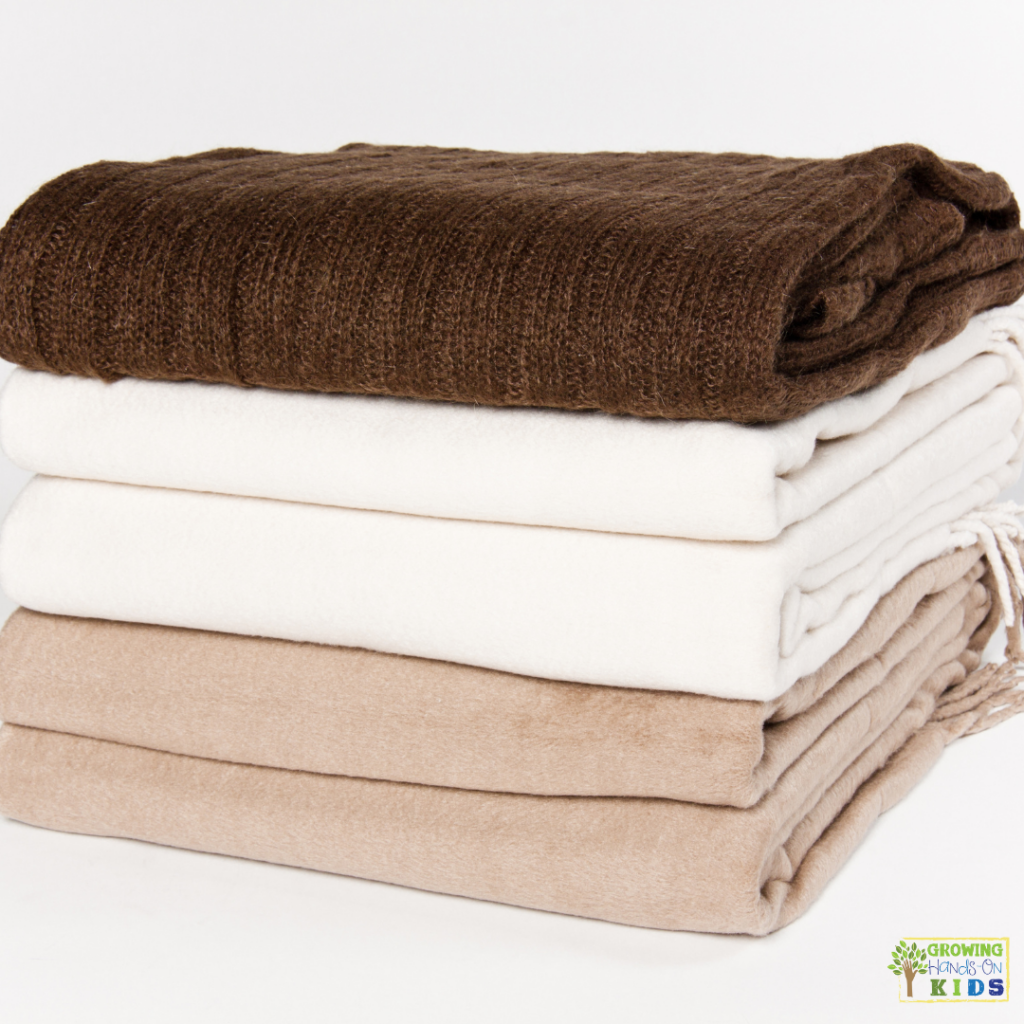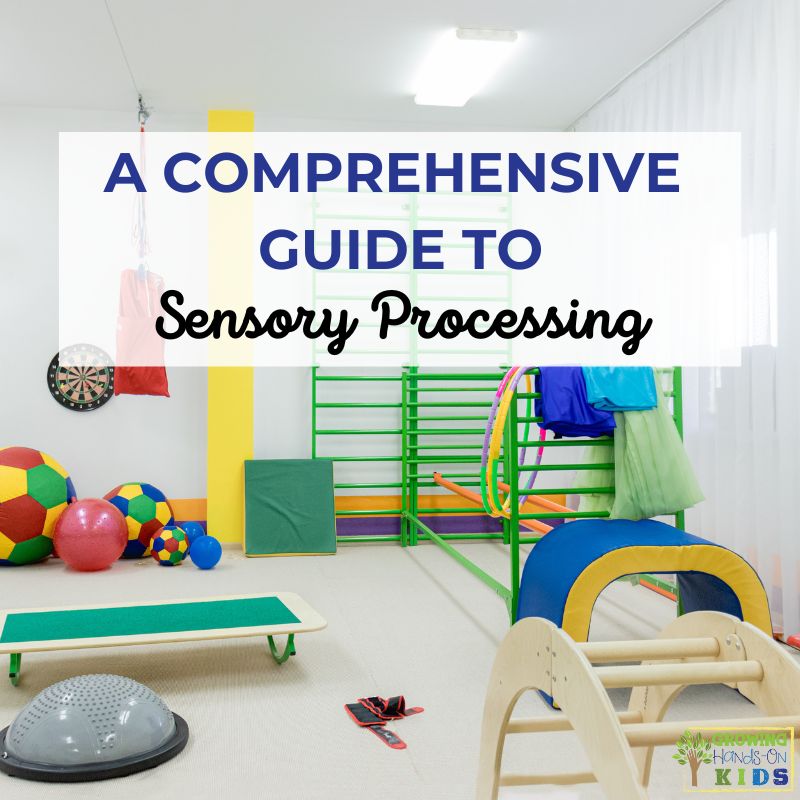Ultimate Guide to Weighted Blankets for Kids and Adults
Affiliate and Referral links are used below to promote products I love and recommend. I receive a commission on any purchases made through these links. Please see my disclosure policy for more details. As an Amazon Associate, I earn from qualifying purchases.
Today I am excited to have a guest interview with Cara Koscinski, OTR/L and co-author of The Weighted Blanket Guide. Cara has graciously allowed me to turn the information she shared with me into a post and compile the ultimate guide to weighted blankets for you today.
What is a weighted blanket and how does it work?
Basically, a weighted blanket is two pieces of fabric sewn together into squares to give even weight distribution. They have been around for a long time, but their use is becoming popular as their benefits and information about them have spread/grown. Weighted blankets are not for keeping warm, but for adding weight to our body for various purposes.
The neat thing is that they are known to benefit people with SO many disorders including autism, SPD, PTSD, chemotherapy, dementia, Fetal Alcohol Syndrome, multiple sclerosis, detoxing, ADHD, and many others.
Also, the results can be felt within seconds of putting on a weighted blanket!
The science behind weighted blankets – What do the studies say?
The BIGGEST misconception about weighted blankets is that there is a ‘standard’ for application, weight, and wearing time! The fact is, that there is limited formal research about weighted blankets. No absolutes nor magic formulas are in existence. This surprised me the most as I wrote the book.
Some OTs have recently been completing research in mental health clinics and have published limited studies. Several groups have attempted to establish guidelines about the use of blankets, however, there has been a cloud of fear surrounding the blankets. This is due to a few deaths that MAY have been caused by weighted blanket use. Upon further review, the blankets in question were applied incorrectly, sometimes even wrapping the child’s face in the blanket.
I personally spoke with Temple Grandin about her ‘squeeze machines’ and the use of weight/pressure. We agreed that weighted blankets work well or don’t work at all. In other words, they work well for those who respond to pressure and tactile input.
When writing the book, my co-author and I did our own research by questionnaire and found many consistencies among therapists and blanket companies: The guideline of 10% plus one pound has spread wildly online. It can be a great starting point however, extreme caution should be used when applied to younger children. Also, NEVER use a weighted blanket for children younger than three years old OR anyone who cannot remove it.
How does deep pressure affect the body and why is it beneficial?
Deep pressure stimulates certain tactile receptors in the skin and when moving against a weighted blanket, users gain proprioceptive input. Generally, deep pressure sensation is calming and helps to regulate our sensory systems. The feeling of the weighted blanket can feel like a hug. The chemical, oxytocin acts on our limbic systems. This chemical can decrease anxiety and stress. Also, dopamine released during hugs or even anticipation of hugs can decrease heart rate, increase the ability to fight infections, and/or decrease blood pressure!
Since each person’s sensory system responds differently, the best way to see how the pressure of weighted blankets feels is to try them! They generally either work well or don’t work at all…..so person specific.
You can read more about the proprioceptive system of the body here.
Who benefits from using weighted blankets?
Honestly, anyone can benefit! We all have sensory systems that can become dysregulated and vary due to genetic and environmental factors. We NEVER recommend use on infants, those under three, and those who (for physical or cognitive reasons) cannot independently remove them. The benefits of the blankets are worldwide and vast! It’s truly exciting that something non-medical can provide such a great benefit.
Do I need an Occupational Therapy eval to get a weighted blanket?
Anyone can purchase a weighted blanket through various companies. Here, in our city, a local non-profit company requires that the treating therapist pick up the blanket. I feel this is best practice. Any sensory diet or activity should be supervised by a certified Occupational Therapist (OT). We are specifically trained in the use of sensory-based interventions for therapeutic benefit.
Since the weighted blanket can be a powerful therapy tool, frequent consultation with an OT for monitoring and re-evaluation is necessary. Parents, schools, and aides need to know how to carry over the blanket use.
Are there any guidelines for weighted blankets we should be aware of?
I suggest using as little weight as is therapeutically necessary. Remember, the popular ‘myth’ of 20 minutes off and 20 minutes on is just that, a myth!
Also, ensure the child can remove the blanket whenever he/she desires. Never use on a child who is unable to remove it. Wearing time depends on individual preference so make sure a blanket is available in any area where calming is designated. Try it both lying and seated to see what feels best.
It’s best to explore the different fabrics to see what you like best. Also, some blankets are made of fleece which adds some ‘warmth.’
When are weighted blankets beneficial?
It really depends on user preference. Use them when feeling upset, anxious, or stressed. They are awesome for sensory rooms, too. Helping users to feel more in control is a great benefit of weighted blankets. They are even being used in mindfulness and grounding techniques.
Check out the book, The Weighted Blanket Guide for a thorough tutorial about making your blanket. They also provide helpful tips for materials, weight, and even getting blankets covered by insurance companies.
Here are a couple of helpful weighted blanket tutorials for hand-made options:
- DIY Weighted Lap Pad
- 13 DIY Weighted Blanket Tutorials – And Next Comes L
- 10 Weighted Vest Tutorials – And Next Comes L
Author Bio: Cara Koscinski OTD, MOT, OTR/L, is a veteran (27 years) pediatric Occupational Therapist. Her two sons are both on the autism spectrum and have sensory processing disorder. Her younger son has mitochondrial disease and uses a feeding tube for nourishment. At times, he requires a wheelchair to get around. She believes her experience as a special needs mom gives her unique empathy for her clients and their families. She also loves speaking across the US for Future Horizons along with Temple Grandin, presenting several continuing education courses around the world. She is the author of 8 books including “The Parent’s Guide to Occupational Therapy for Autism & Special Needs”, “The Special Needs SCHOOL Survival Guide”, and “The Weighted Blanket Guide”. You can find her on her website, Cara Koscinski.com.
You May Also Like:

Heather Greutman, COTA
Heather Greutman is a Certified Occupational Therapy Assistant with experience in school-based OT services for preschool through high school. She uses her background to share child development tips, tools, and strategies for parents, educators, and therapists. She is the author of many ebooks including The Basics of Fine Motor Skills, and Basics of Pre-Writing Skills, and co-author of Sensory Processing Explained: A Handbook for Parents and Educators.



Hi,
Nice article…one comment..the idea of 10% of body weight as you pointed out, is not entirely correct. The study that number came from actually had nothing to do with weighted blankets but was an article by the American Academy of Pediatrics in the Pediatrics magazine referencing a research paper on injuries from using school backpacks … it had nothing to do with weighted blankets. The other reason that it is misleading is that weighted blankets come in a variety of sizes and simply looking for a 10 pound blanket is meaningless, since 10 pounds in a small 37″ x 52″ blanket will produce a much higher pressure (lbs/sq ft) than the same 10 pounds in a queen size blanket where the weight is distributed over a wider area. The last point to be made on weight is that with a backpack or weighted piece of clothing like a vest the entire weight is carried by the child or adult using it… whereas in a blanket most of the blanket’s weight is actually on the mattress and not on the person using it .
I make weighted blankets for a living and one of the biggest challenges is trying to educate the public on what information is actually out there and what is simply urban legend or misappropriated data.
Thanks very much for the article and for letting me post a comment.
Irlanda Corrales
I have read a lot of great things about the use of weighted blankets. A lot of children respond well to them, but as with anything some don’t. Great guidelines, and information – thanks for sharing!